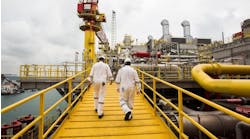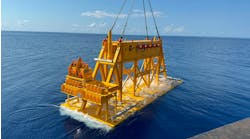Chain manufacturer Ramnäs is making progress in its efforts to establish a new anchor chain grade, designated Grade 5. Early this year, the company received draft specifications for comment from the ABS classification society. Norwegian classification society DNV also is working with Grade 5 specs.
Last year, Ramnäs delivered anchor chain of the highest grade in its history. The delivery, which consisted of 35 1,600-ft lengths of 3.25-in. chain weighing 2,578 metric tons, was made to drilling rig owner Diamond Offshore.
According to marketing manager Nils Nilsson, this chain has a strength equivalent to Grade 5, though the designation cannot yet be used as the specifications have not yet been approved. Instead, the chain, which was approved by ABS, was specified as Grade 4 EHS (Extra High Strength).
Grade 5 will have a proof-load and a break-load both 16% higher than Grade 4. Its yield strength will be 700 MPa, and its ultimate tensile strength 1,000 MPa. This compares with 580 MPa yield strength and 860 MPa ultimate tensile strength for Grade 4.
In addition to 4 EHS, Ramnäs offers 4+, 4++, and 4 HS (High Strength) chain, all products with a strength exceeding Grade 4. While 4 HS, like 4 EHS, consists of standard 76 mm studlink chain, both 4+ and 4++ involve chain with larger dimensions. The company has made three deliveries of 4+ chain.
During March, Ramnäs was expecting to receive the full results of fatigue and stress corrosion tests on Grade 5 chain, both studlink and studless varieties, which it commissioned from the Royal Institute of Technology in Stockholm. It would then consider whether more tests were required, according to Olle Wandin, an engineer in the production department.
The need for Grade 5 is market-driven, says Nilsson. Demand from the drilling contractor segment was stimulated following the extreme conditions to which rigs’ mooring systems were put by Hurricane Katrina in the Gulf of Mexico in 2005. In this case, operators are looking for chain with a greater breaking strength than that provided by existing grades.
A second source of demand comes from operators of floating production facilities, especially in deep waters. Their intention is to take advantage of higher-strength chain to achieve the same breaking load with smaller dimensions as can be achieved with existing grades in larger dimensions. In this way, the weight of an installation’s mooring system can be reduced while its strength is maintained.
For more information contact Nils Nilsson, Ramnäs Bruk. Tel +46 220 220 27, fax +46 220 358 37,[email protected], www.ramnas.com




